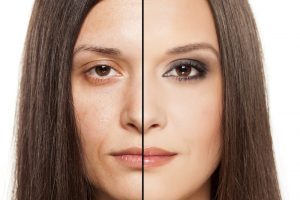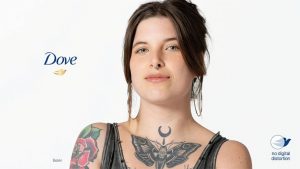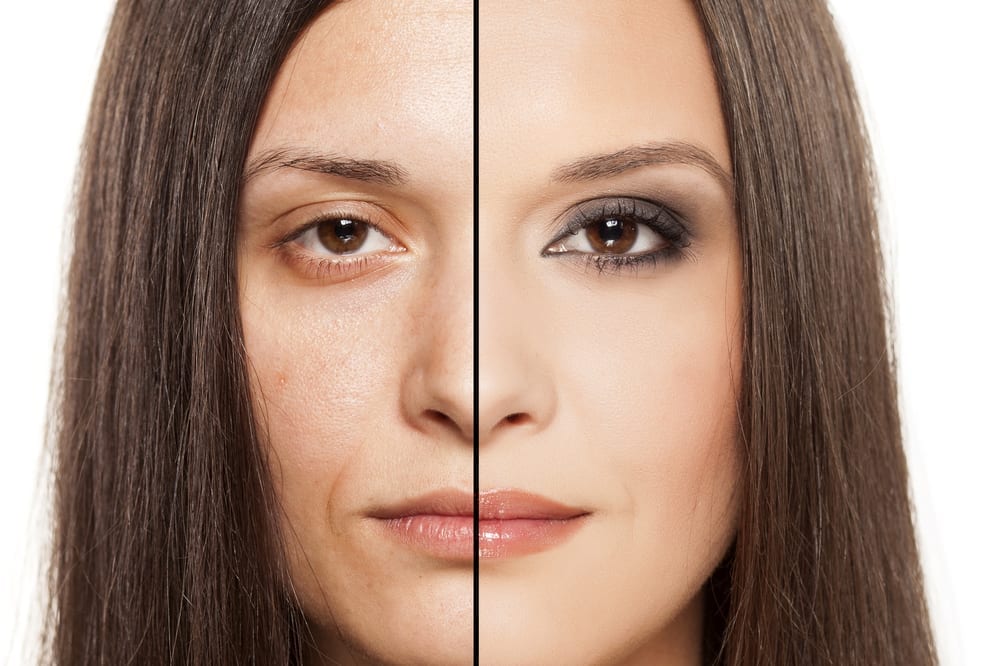 Cause Marketing—marketing strategies that promote a social cause rather than a product—can be powerful when 1) the cause is relevant for the brand and 2) when the cause has meaning for the brand’s customers. Doing this well is a long game, not a flash-in-the-pan campaign, that must reflect the values of the brand rather than social expediency. There have been several prosocial marketing campaigns, such as those by TOMS Shoes, Patagonia, Live Strong and Dove. Dove, which ironically sells beauty products, has taken a stand in the war against unattainable beauty standards. They have had several successful campaigns under the Real Beauty Master Campaign. First, they got everyone’s attention in 2016 with the viral success of the “Dove Evolution” video, showing the effects of photoediting. They are making news again by labeling all unretouched photos with a Dove-branded symbol, “No Digital Distortion.” (See the announcement on Adweek.)
Cause Marketing—marketing strategies that promote a social cause rather than a product—can be powerful when 1) the cause is relevant for the brand and 2) when the cause has meaning for the brand’s customers. Doing this well is a long game, not a flash-in-the-pan campaign, that must reflect the values of the brand rather than social expediency. There have been several prosocial marketing campaigns, such as those by TOMS Shoes, Patagonia, Live Strong and Dove. Dove, which ironically sells beauty products, has taken a stand in the war against unattainable beauty standards. They have had several successful campaigns under the Real Beauty Master Campaign. First, they got everyone’s attention in 2016 with the viral success of the “Dove Evolution” video, showing the effects of photoediting. They are making news again by labeling all unretouched photos with a Dove-branded symbol, “No Digital Distortion.” (See the announcement on Adweek.)
In addition to these prosocial marketing efforts, it’s important to understand how to integrate these campaigns with broader marketing strategies effectively. For example, utilizing social media platforms to amplify the message and engage with audiences can significantly enhance the campaign’s reach. More about influencer marketing agencies in Europe can provide insights on collaborating with influencers who share your brand values, creating authentic content that resonates with your target demographic. Influencers can help bridge the gap between the brand and the audience, making the cause more relatable and impactful.
Moreover, consistency and authenticity are key. Brands must ensure that their commitment to the cause is evident in all aspects of their operations, from product development to customer service. This consistency builds trust and reinforces the brand’s dedication to the cause, making it more than just a marketing tactic. When done correctly, cause marketing not only boosts brand loyalty but also contributes positively to society, creating a win-win situation for both the brand and its customers.
Dove’s campaign captured the social backlash against unrealistic body images in the media. This has allowed them to position their brand as synonymous with the fight for self-acceptance and self-esteem in an era where body image satisfaction is reportedly low. Their infamous Evolution video detailed the transformation of a woman’s face from the no make-up starting point to a billboard-ready image thanks to a team of beauty specialists and PhotoShop wizards, who, among other things, lengthened the neck and enlarged the eyes. This video spawned a series of copycat exposures of PhotoShop alternations, including magazine covers of celebrities such as Faith Hill and Jessica Alba. It also underscored the insidious futility of comparing oneself to advertising images yet plagues many women.
 Cause marketing is hard to sustain, but Dove picked a good cause to champion. Body Image Dissatisfaction has long been a concern, rising with the spread of mass media and then exploding along with social media. Where brands often make the mistake of veering off their core narrative when the click-throughs slow, Dove, has not only stuck to it, but have managed, in their most recent move, to raise the ante for other brands. I’m sure they hope their new “No Digital Distortion” label that certifies the lack of computer manipulation will become the equivalent to the “Good Housekeeping Seal of Approval” for published images.
Cause marketing is hard to sustain, but Dove picked a good cause to champion. Body Image Dissatisfaction has long been a concern, rising with the spread of mass media and then exploding along with social media. Where brands often make the mistake of veering off their core narrative when the click-throughs slow, Dove, has not only stuck to it, but have managed, in their most recent move, to raise the ante for other brands. I’m sure they hope their new “No Digital Distortion” label that certifies the lack of computer manipulation will become the equivalent to the “Good Housekeeping Seal of Approval” for published images.
Dove simultaneously sets a new standard for unretouched images and Cause Marketing
The great thing about cause marketing, from a positive psychology perspective, is that it moves the messaging from deficit messaging aimed at ‘what’s wrong’ with the consumer as the main motivational trigger to targeting empowerment and building strengths. Dove started by exposing the prevalence of alteration and manipulation of images that present unrealistic and unattainable standards of physical beauty and moved to self-esteem. In doing so, Dove hit a sweet spot in the socio-cultural narratives, targeting a prevalent issue in social discourse, particularly among women, that of body image dissatisfaction and self-esteem.
Cause marketing is powerful when it elevates a brand meaning beyond a product line. Many companies have excellent cause marketing campaigns. Few achieve a level of identity “confusion” where the cause and the brand are inseparable in the consumer’s mind. Patagonia is one. Dove is another. Dove is as well known for their pro-real-woman, anti-PhotoShopping images as they are for their soap. Granted, they haven’t always gotten it right, such as the ill-conceived and short-lived 2017 campaign that had racist overtones, but their retreat was hasty and, in keeping with the authenticity they are promoting, they quickly acknowledged their mistake. Dove doesn’t sell products, they sell self-acceptance and self-esteem.
Focusing on social issues instead of products is a disruptive approach to marketing. We have seen other examples, but few have the tenacity and success of shifting mental models. The “No Digital Distortion” label is be placed on every photo that hasn’t been digitally manipulated. It is a certification that says, “no enlarged eyes, erased wrinkles, vanished blemishes, trimmed waists, or lengthened necks here.” Equally important from a market differentiation perspective, this label creates a challenge for other marketers in an environment where consumers are increasingly fed up with being manipulated.
The lack of a label may now have even bigger meaning. If there’s no label, is it altered? There are certain products where the absence of certification speaks very loudly—organic, nonGMO, animal testing, to name a few. This puts other marketers in a real bind as to how to demonstrate their own image authenticity and respect for the consumer. In a world where facts are under attack, credentialed sources are increasingly important. People yearn not only for accurate information but some assurance. When 70% of the population worries about fake news and “the media” is the least trusted institution compared to government and business, the natural instinct is to look for a way to validate information. If I were the NY Times or CNN, I might consider an equivalent way of indicating validation of content.
The crisis in confidence over information makes the timing of Dove’s anti-distortion label even more relevant.
In this crisis of confidence over information, outing PhotoShopped images is pretty low-hanging fruit, but speaks to a deep need for certainty. Marking authenticity becomes a symbolic act, if not a sad commentary on popular culture.
Before social media took serious hold, the body image dissatisfaction debate centered on the negative impact of standards defined by curated images of beauty that filled mass media, from Kate Moss and ‘heroin chic’ to Barbie. The hypothesis was that if these artificial and unattainable standards were removed and replaced with real people and more realistic proportions, that measures of body image satisfaction would improve. It hasn’t happened as researchers hoped. Be careful what you wish for. Social media opened the floodgates to millions upon millions of real people and has become complicated by other features enabled by the social environment. Body image dissatisfaction remains a problem.
My research on digital media and body image found that over 60% of the participants reported being aware of digital manipulation in advertising images and considered themselves well informed and aware of media influences. An even higher number, (75%) of the participants polled, believed that producers manipulated almost all advertising images. Yet in spite of this professed knowledge, over half reported frequently comparing themselves to media representations and feeling a worse as a result. This was a surprisingly high number given the percent who claimed awareness of image manipulation. What was even more interesting, however, was that more participants compared themselves to their friends and social groups than to the curated images of models and celebrities. These also reported still feeling unhappy about themselves. Contrary to earlier hypotheses, seeing pictures of other real people did not influence how they felt about themselves. It’s not quite the self-esteem bonanza hoped for by those who promoted images of real people as a way to renorm beauty standards.
These findings are just from a single study, but they suggest a few things worth noting.
The first is that the conversation is changing. Companies like Dove who undertake to move the conversation can have an impact, but they aren’t the cure. There are no easy answers. The impact of social media has drawn increasing attention to the insidious social pressures to be “beautiful” by arbitrary, often artificial and continually changing standards. Real people are now “Influencers,” a new class of celebrity borne of social media. Influencers are dangerous in that they masquerade as people you know, turning an advertisement into a word-of-mouth endorsement from a trusted friend.
Photo retouching is now common knowledge but there is a peculiar double standard. Consumers take offense at advertising manipulation, yet mobile devices have image editing apps, including those built into commonly used platforms like Instagram and Snap and everyone has the ability to capture, “adjust,” and post images in hopes of receiving Likes and Loves from friends. Social validation is a heady drug. This draws attention to the need for critical thinking and media literacy as part of our educational system. You can’t compete with the reward cycle triggered by daily social activity without increasing the frequency, sense of relevance and appeal of the educational messaging.
It also reminds us that social comparison happens all the time, always has and always will. We make a mistake when we villainize it rather than recognize it as normal–an innate social response–and help our kids (and ourselves) build the skills, strengths, and resilience to identify it and reframe it. When we make normal reactions shameful, we suppress them, rather than figure out how to manage them and use them to our advantage. Remember, social comparison is also what fuels aspiration and mentoring—it’s all a question of what you’re comparing.
Finally, it also underscores that self-esteem is complicated. Many things can contribute to self-image and self-esteem, not just what we see in the media. As numerous psychologists, from Bandura and Dweck to Ryan and Deci, have been telling us for years, much of it comes from feeling competent, a sense of mastery, that what we do matters and that we are valued and loved. In another blatant plug for positive psychology, raising confident young people is about building internal strengths and values so they feel good, not just look good. Worrying about the need for comparison to peers is fruitless — it won’t go away and blaming over an innate instinct actually makes someone feel worse. What matters is how much of our worth and power we attribute to external versus internal qualities and that doesn’t come from lectures. It comes from building a sense of one’s strengths and competencies. These are enduring and can grow over time. Physical beauty changes and is subject to whims and trends.
Cause marketing has been around for about 50 years but is increasingly relevant today where 91% of consumers in a global study said they are more likely to choose products that support a good cause, even if it means paying a little more. The increasing use of cause marketing is a reflection of market shifts: greater transparency, more empowered consumers and digital communications that facilitate cause adoption and support generation. It is also a result of all the companies who understand that Corporate Social Responsibility, like customer service, product design. and employee working conditions is not separate from marketing. Every touchpoint is part of the brand story, reflecting the company’s values and mission. Dove is just one example of a company who adopted a cause and continues to push a socially-relevant and prosocial conversation. They also have a much bigger marketing budget than any PSA from a government agency. Sure, it has genuine business benefits but also lets them be a force for good. Just the media attention generated by the “No Digital Distortion” mark is a win for both sides.

 Dr. Pamela Rutledge is available to reporters for comments on the psychological and social impact of media and technology on individuals, society, organizations and brands.
Dr. Pamela Rutledge is available to reporters for comments on the psychological and social impact of media and technology on individuals, society, organizations and brands.